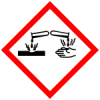Toxicty
GHS safety labels
- H271

May cause fire or explosion; strong oxidizer
Class: Oxidizing
Subclass: Liquids - H301

Toxic if swallowed
Class: Acute Toxicity
Subclass: Oral - H311

Toxic in contact with skin
Class: Acute Toxicity
Subclass: Dermal - H314

Causes severe skin burns and eye damage
Class: Corrosion/irritation
Subclass: Skin - H317

May cause an allergic skin reaction
Class: Sensitization
Subclass: Skin - H330

Fatal if inhaled
Class: Acute Toxicity
Subclass: Inhalation - H334
May cause allergy or asthma symptoms or breathing difficulties if inhaled
Class: Sensitization
Subclass: Respiratory - H340

May cause genetic defects (state route of exposure if it is conclusively proven that no other routes of exposure cause the hazard)
Class: Germ Cell Mutagenicity - H350

May cause cancer (state route of exposure if it is conclusively proven that no other routes of exposure cause the hazard)
Class: Carcinogenicity - H361

Suspected of damaging fertility or the unborn child (state specific effect if known)(state route of exposure if it is conclusively proven that no other routes of exposure cause the hazard)
Class: Toxic to Reproduction - H372

Causes damage to organs (state all organs affected, if known) through prolonged or repeated exposure (state route of exposure if it is conclusively proven that no other routes of exposure cause the hazard)
Class: STOT
Subclass: Repeated exposure - H400

Very toxic to aquatic life
Class: Aquatic
Subclass: Acute - H410

Very toxic to aquatic life with long lasting effects
Class: Aquatic
Subclass: Chronic
